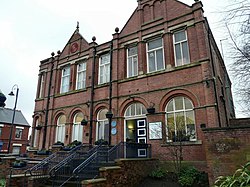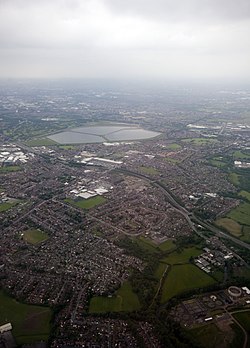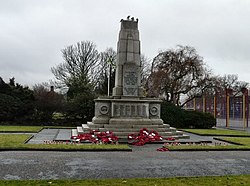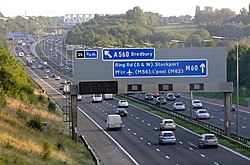Denton, Lancashire
| Denton | |
| Lancashire | |
|---|---|
 Denton Town Hall | |
| Location | |
| Grid reference: | SJ925954 |
| Location: | 53°27’19"N, 2°6’44"W |
| Data | |
| Population: | 36,591 (2011) |
| Post town: | Manchester |
| Postcode: | M34 |
| Dialling code: | 0161 |
| Local Government | |
| Council: | Tameside |
| Parliamentary constituency: |
Denton and Reddish |
Denton is a town in south-east Lancashire, five miles east of Manchester. it had a population of 36,591 at the 2011 Census.[1][2][3]
Contents
History
Toponymy
Denton probably derives its name from Dane-town, an etymology supported by other place names in the area such as Danehead-bank and Daneditch-bourne.[4] The word 'Dane' is itself derived from Anglo-Saxon denu, dene, daenland, meaning a valley. So literally Denton means valley town.
Prehistory
A Byzantine coin was discovered in Danesheadbank, dating from the sixth or seventh century, as part of the Denton coin hoard.[5] The early mediæval linear earthwork Nico Ditch passes through Denton; it was probably used as an administrative boundary and dates from the 8th or 9th centuries. A 330-yard stretch is still visible on Denton golf course, about 13 ft wide and 5 ft deep.[6]
Middle Ages
In the early 13th century it lay within the Manor of Withington, a feudal estate which also encompassed the townships of Withington, Didsbury, Chorlton-cum-Hardy, Moss Side, Rusholme, Burnage and Haughton, ruled by the Hathersage, Longford, Mosley and Tatton families.[7]
Hat industry
Felt hatting was recorded in Denton as early as 1702 and Denton gained supremacy in the hatting industry towards the end of the 19th century. The increasing importance of Denton and Haughton as centres of felt hat production is demonstrated by the increase of manufacturers in the area: in 1800 there were 4 hatting firms in Denton and Haughton, but by 1825 there were 25 manufacturers, making it the third largest hat making centre in the north west. By 1840, 24,000 felt hats were produced in Denton a week. The prosperity of the hatting industry is reflected in the growth of the town from 2,501 in 1801 to 6,759 in 1841.[8]
During the 1840s, the felt hat industry went into depression; the recession affected Denton, with wages in the area falling by 35% and only 12 hat manufacturers remaining in Denton. The depression was partially due to changes in fashion away from felt towards silk hats. The revitalisation of the felt hat industry came in the 1850s, once again on a whim of fashion but also the increased use of machinery led to reduced production costs. The resurgence was demonstrated by the doubling of the number of hat manufacturers in the town between 1861 and 1872. At its peak in the Edwardian period, Denton's felt hat industry was the largest felt hat manufacturing centre in Britain. There were 36 firms directly involved in the felt hat making industry. In 1907 the majority of the 16,428,000 felt hats made in England (worth £2,068,000) were made in Denton and Stockport. In 1921, the working population of Denton was 9,653 with about 41% of those people in occupations related to the hatting industry. The last hat factory in Denton closed in 1980.[8]
Although the felt hat industry in Denton and Haughton was prosperous and an integral part of the town, working conditions in the factories were not risk free. One of the problems workers faced was mercury poisoning; mercury was used to separate the fur from the rabbit hide and workers were in regular contact with fur impregnated with mercury or exposed to mercury vapour. Inadequate ventilation in some parts of the hat making process led to other sorts of dangers; solvents were also used and on 14 January 1901 there was an explosion at the factory of Joseph Wilson & Sons in Denton, killing 13 people and injuring many more. The explosion was of vapour from methylated spirits used in the dying process.[8]
Throughout the 19th century and well into the 20th century, a wide range of hats was manufactured to suit all tastes and purses. The names used by the competing manufacturers to describe their products was bewildering and some of these were; felt hats, silk hats, fur hats, wear fur hats, soft hats, stiff hats, velour hats, wool hats, straw hats and, of course, the ubiquitous cloth cap. In the 1930s the 'Attaboy' trilby hat was introduced by the Denton Hat Company. This brand quickly became famous and it was in production for many years. Ladies' hats were not forgotten either and at least one works specialised in making these and the hat master's wife designed them at home. Hats were made for home consumption and for export. The well-known slogan "If you want to get ahead, get a hat" arose in Denton and, needless to say, anyone attending for a job interview not wearing a hat was quickly shown the door! Similarly, until the early 20th century, anyone entering a Denton shop without a hat would receive much cursing.
In 2003, the prominent Wilson's Hat Factory on Wilton Street, together with the adjacent mill-workers' houses, other factories, Wilton Street Chapel and Mainstream Studios was demolished to make way for a new retail shopping park 'Crown Point North', part of a major town centre regeneration scheme.
Coal mining
Denton is situated on the Lancashire coalfield and once had a number of collieries in operation. These included the Ellis Colliery (Which became Denton Colliery), Top Pit, Hard Mine Pit and, further south and near to the river Tame, Hulmes Pit. Much of the coal that they produced was consumed by local industry, there being an abundance of steam powered mills in the area.
Denton Colliery was the largest of these mines and eventually absorbed the other local pits, often using their shafts for ventilation or, in the case of Hulmes Pit, as a pumping station to drain water from the main workings. Denton Colliery was connected to the London & North Western Railway's line from Guide Bridge to Stockport by a standard-gauge tramway. The tramway was worked by steam power, rather than horses, as evidenced by a photograph held in the Tameside Local History Library archives.
In 1926, miners at Denton Colliery joined the national strike against reduced wages and longer working hours. This dispute led to the general strike (3–12 May 1926). When the general strike was called off, coal miners stayed out for several more months.
As the strike started to crumble, miners at Denton Colliery remained steadfast, not returning to work until 5 November 1926,[9] some 6 weeks and one day after their colleagues at the nearby Ashton Moss Colliery, the only other significant colliery left in Tameside at that time. They returned to face longer working hours and their pre-strike rates of pay.
Unfortunately, months without maintenance during the strike had taken their toll on many coal mines. Denton Colliery had flooded to the extent that it was no longer workable and the Denton Colliery Co. went into voluntary liquidation in 1929. The headstock was demolished in 1932 and the shaft was finally filled and capped in 1974.[9]
Some traces of Denton Colliery can still be found. The colliery offices, situated on Stockport Road, still stand and are now the showroom of a company of monumental stonemasons. Behind the office building is a small section of wall from the colliery. On the opposite side of the road and slightly nearer to Crown Point is the building that once housed the local mines rescue station, now two private houses. Two miners cottages, much altered and now converted into one house, stand near the junction of Stockport Road and Cemetery Road. The foundations of Hulmes Pit were excavated during the early 1970s and can still be seen. Parts of the track bed of the tramway to Denton Colliery can still be traced, both on modern maps and on the ground, as can traces of a canal, known as the Beat Bank Branch, intended to link local collieries to the Stockport branch of the Ashton Canal at Reddish, which was partially built and then abandoned.
Oldham Batteries
After hatting, the most important industry in Denton was the manufacture of lead-acid batteries by Oldham Batteries (Oldham & Son Ltd). In 1865, Joseph Oldham established a millwright general engineering shop and by 1887 this company was manufacturing machinery for the hat-making industry. Another important industry in the area was coal mining and shortly after 1887 the company began making machinery and equipment for this industry, which included miners' portable lamps. Up to this time, miners had always used the safety lamp devised in 1815 by Sir Humphry Davy (1778–1829) but this new battery-powered Davy lamp eventually replaced the traditional safety lamp.
In 1920, the manufacture of automotive batteries for commercial vehicles, cars and motorcycles commenced and over the years this business expanded into the manufacture of traction batteries, which also included submarine batteries.
Nonetheless, the company never converted exclusively to the manufacture of batteries and they still continued to make machinery for the hatting industry, general engineering equipment, portable lamps and lighting systems as well as helmet-lamps and other related equipment for the mining industry. It also produced attachments for the mechanical handling industry.
Oldham Batteries became a major Denton employer with over 1,000 employees, but by the beginning of 2002 the decision to close the factory had been made. The factory, which used to be off Lime Grove, Denton, is no longer there. It has been demolished, and a planning application for a further town centre retail park has been approved by Tameside Council.
Landmarks
There is one main war memorial, or cenotaph, in Denton, located in Victoria Park. This memorial commemorates people from Denton and Haughton who served in two world wars. The names on the war memorial were collected from their relatives who wrote to the council with details of their loved ones who served in either war. The war memorial was unveiled on 23 July 1921. Figures from the Denton section of the Tameside council website, state that 3,500 Denton men served in the Great War (1914–1918), of that number, 369 people were killed.
The oldest church in Denton is St Lawrence's. It is almost 500 years old, originally built in 1531. It is a listed Grade II* building.[10] The church is also known locally as "Th'owd Peg" (the old peg) due to the fact, as a timber-framed building, it was constructed with wooden pegs rather than nails. It is more commonly known as the black and white church, because of its appearance. A local myth is also said to have a pirate buried within its grounds because of a grave stone marked with a skull and crossbones at its front door. In a more thorough investigation and article printed by Denton Local History Society (1995), it was found that the gravestone was actually a masonic gravestone belonging to a deceased Soldier named Samuel Bromley from the Royal Artillery.
The magnificent Victorian St Anne's Church, Haughton, is a Grade-I listed building, and is built in the Gothic Revival style.[11]
Transport
One of Denton's claims to fame is that, along with Reddish South, it has the UK's least frequent train service, every Friday, in one direction, from Stockport to Stalybridge.
There are bus links to Manchester city centre, Hyde, Ashton-under-Lyne and Stockport.
Sports
Cricket
Denton is home to three semi-professional cricket clubs:
- Denton CC play at Egerton Street. They were league champions in 1994 and 1995 (runners up in 1998) with previous professionals including West Indies players Malcolm Marshall and Kenneth Benjamin.
- Denton West CC (until 1947, Reddish & Gorton CC) play at Windsor Park, opposite the Library, in the Dane Bank area of Denton. They have a long history of Sri Lankan professionals including the first, Test Player Tony Opatha, in 1976. They were league champions in 1996, 1997, 2002, 2003, 2009, 2010 & 2013 and Walkden Cup winners in 1975, 1998, 2009, 2012 & 2014. The 2014 professional was Steve Oddy.
- Denton St Lawrence CC play at Sycamore Park and their 2005 professional was West Indian Ryan Nurse. In July 2005 they won the Walkden Cup for the first time in 30 years defeating Flowery Field Cricket Club.
Football
- Denton Town FC play in the Cheshire Football League. The club was formed in 1920 as Bradford Parish and was a force in local non-league football for many years before relocating with a change of name in the mid-1990s, their ground is now based on the Whittles Park Estate in south east Denton.
Notable people
Notable people who come from Denton include:
- Jimmy Armfield OBE, England footballer. Freeman of the Borough of Blackpool, was born in Denton. Although he has spent most of his life in Blackpool, he was honoured by Tameside Council in July 2009 and was presented with a lifetime achievement award by Denton and Audenshaw District Assembly.
- Thomas Bowler (17 September 1826 – 15 September 1893) and his uncle: William (25 January 1808 – 1878): Hatters, who were born in Denton and moved to Southwark around 1840/1, where they became involved in the development of the hat which bears their name.[12]
- Mick Hucknall, who became the lead singer of Simply Red lived in Denton and attended Audenshaw School.
- Sir Geoff Hurst the West Ham United and England 1966 World Cup footballer lived in Denton until he was 8-years old. His grandfather lived on Cemetery Road until his death.
- Paul Lake, from Haughton Green attended St Thomas More Roman Catholic College and played for Manchester City until his career was cut short with a knee injury.
- Alan "Reni" Wren, lived in Denton and attended Egerton Park Arts College and is the drummer for The Stone Roses.
- Col Needham, Creator of the Internet Movie Database (IMDB) lived in Denton
References
- ↑ "Population Data 2011 Census". ONS. http://www.citypopulation.de/php/uk-england-northwestengland.php?cityid=E35000254.
- ↑ "See Ward Profiles for Denton North East, Denton West (Dane Bank) and Denton South". Tameside MBC and ONS data from 2001 Census. http://www.tameside.gov.uk/Denton.
- ↑ "Urban Areas in the North 2001 Census". ONS. http://www.ons.gov.uk/ons/rel/census/census-2001-key-statistics/urban-areas-in-the-north/urban-areas-in-the-north-part-4.pdf.
- ↑ "Denby – Denton, West". A Topographical Dictionary of England (1848), pp. 28–32. British History Online. http://british-history.ac.uk/report.asp?compid=50917. Retrieved 22 April 2007.
- ↑ Mike Nevell (1992). Tameside Before 1066. Tameside Council. p. 76. ISBN 1-871324-07-6.
- ↑ Mike Nevell (1998). Lands and Lordships in Tameside. Tameside Council with the University of Manchester Archaeological Unit. pp. 40–41. ISBN 1-871324-18-1.
- ↑ Sussex & Helm (1988). Looking Back at Withington and Didsbury. Willow. p. 45. ISBN 0-946361-25-8.
- ↑ 8.0 8.1 8.2 Mike Nevell, Brian Grimsditch and Ivan Hradil (2007). Denton and the Archaeology of the Felt Hatting Industry. Tameside Council and University of Manchester Archaeological Unit. pp. 26, 29–32, 40, 74–76. ISBN 1-871324-36-X.
- ↑ 9.0 9.1 C. Wilkins-Jones, Tameside, Tameside Metropolitan Libraries Committee, 1978
- ↑ Mike Nevell (1991). Tameside 1066–1700. Tameside Council and University of Manchester Archaeological Unit. pp. 80, 86, 123–4, 136. ISBN 1-871324-02-5.
- ↑ Mike Nevell (1993). Tameside 1700–1930. Tameside Council and University of Manchester Archaeological Unit. p. 143. ISBN 1-871324-08-4.
- ↑ Hopkins, Susie (2004). "Bowler, William". Oxford Dictionary of National Biography. Oxford University Press. http://www.oxforddnb.com/view/articleHL/63532. Retrieved 29 November 2006.
Outside links
| ("Wikimedia Commons" has material about Denton, Lancashire) |
- Tameside Council website – Section about Denton
- Virtual Tameside site – Information about St. Lawrence's Church
- dentonlocalhistorysociety.co.uk – Official Webpage of the Denton Local History Society
- Denton Manchester – Resources on Denton


